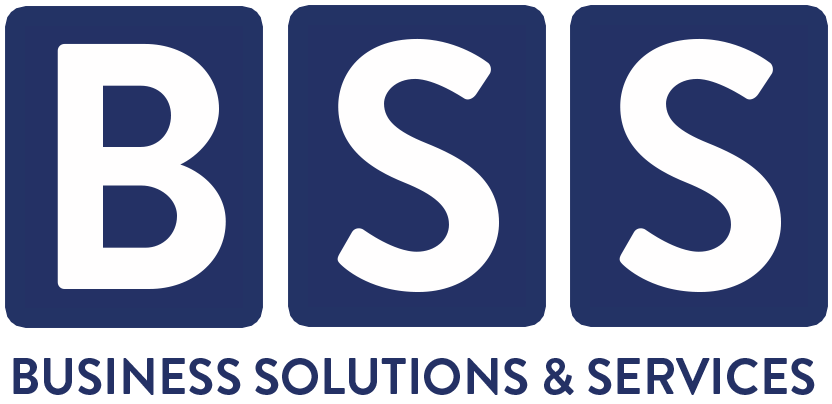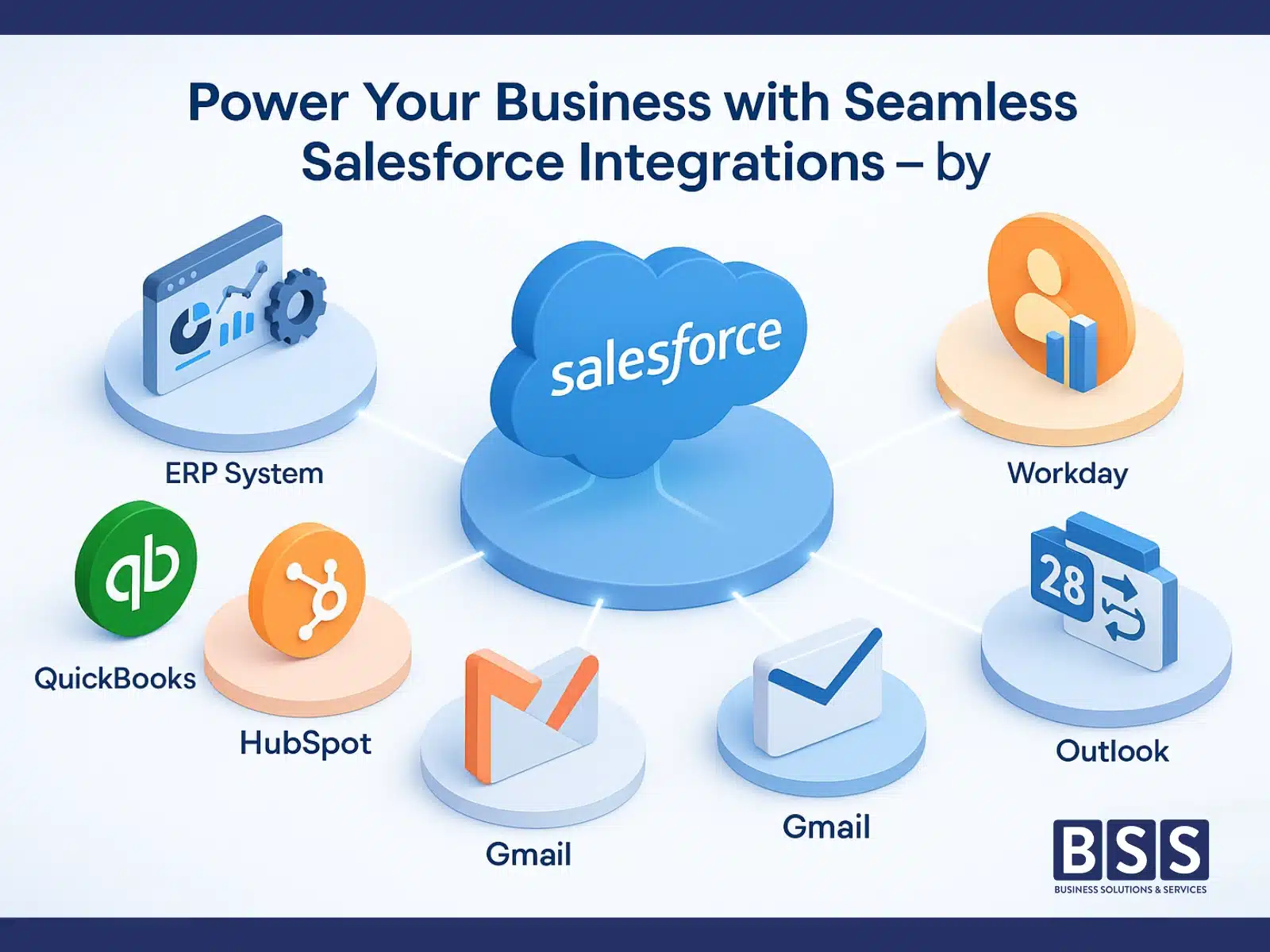In today’s competitive digital economy, businesses can’t afford disconnected systems or manual data silos. Customers expect seamless, responsive service, while leaders need real‑time insights to make faster decisions.
That’s where BSS Universal’s Salesforce Integration Services bridge the gap — connecting your CRM with ERPs, QuickBooks, HubSpot, Gmail, Outlook, marketing tools, and even advanced tools like Salesforce Authenticator and Salesforce Maps.
We don’t just “connect systems.” We engineer integrations that transform your operations: automating workflows, improving data accuracy, and unlocking growth.
Why Salesforce Integration Truly Matters (Backed by Experience)
Based on years of hands‑on experience — from Salesforce Marketing Cloud WhatsApp Integration to niche solutions like Salesforce Zendesk Integration — here’s what successful integration delivers:
✅ Unified data: Combine ERP, accounting tools, Outlook calendars, Gmail threads, even Salesforce Marketing Cloud campaigns — into one view.
✅ Time & cost savings: Automate manual tasks, reduce errors, and free up teams for strategic work.
✅ Real‑time decision‑making: Spot trends instantly via Salesforce dashboards.
✅ Stronger customer experience: Faster, consistent responses across every channel.
✅ Future‑proof scalability: Integrate new tools — like Salesforce Quip, Revenue Cloud, or even Salesforce Vlocity — as your business grows.
At BSS Universal, we handle complex challenges, like Salesforce sandbox deployments, multi‑cloud architectures, and tools like Salesforce Inspector Reloaded to debug integrations faster.
Our Proven Salesforce Integration Process
Step 1: Business Discovery
We explore:
Which tools matter most? ERP, QuickBooks, marketing automation, Salesforce Outlook Plugin, etc.
One‑way vs. two‑way sync
Realtime vs. batch updates
Key Salesforce objects: Leads, Opportunities, Orders
Step 2: Choose Integration Method
API‑Based (using Salesforce REST/SOAP APIs, Salesforce CLI, Data Loader)
AppExchange (QuickBooks, HubSpot, Mailchimp)
Middleware (MuleSoft, Dell Boomi, Informatica Cloud — now part of Salesforce through the Informatica acquisition)
Step 3: Secure & Configure API Access
We enable secure connections between Salesforce and your external systems:
Create Connected Apps in Salesforce
Set OAuth scopes (like
api,refresh_token)Generate secure Client ID & Secret
Apply IP restrictions and security policies
This protects your data while allowing real‑time data flow.
Step 4: Authentication & Authorization
Using OAuth 2.0:
Generate and refresh access tokens safely
Choose the right OAuth flow (e.g., username-password for server processes or authorization code for user apps)
Set up token storage, revocation, and expiration handling
This ensures only authorized users and systems access your data.
Step 5: Data Mapping & Transformation
We align external fields and Salesforce objects:
Match data types, handle format changes, and set up field concatenation if needed
Add validation to avoid duplicates and improve data quality
Build transformation rules so your systems “speak the same language”
This step ensures your dashboards and reports show accurate and relevant information.
Step 6: Develop & Implement Integration Logic
Depending on your scope and systems, we:
Use Salesforce REST/SOAP APIs for CRUD (create, read, update, delete) operations
Write Apex triggers and classes to automate business rules inside Salesforce
Leverage tools like Salesforce Inspector, Postman, or Workbench for testing
Use middleware (e.g., MuleSoft, Dell Boomi) for complex multi‑system sync
Step 7: Error Handling & Logging
Robust monitoring includes:
Salesforce debug logs and custom logs
Automated alerts when syncs fail
Retry strategies and fallback logic
User‑friendly dashboards so your teams can see data sync health at a glance
Step 8: Rigorous Testing
Before go‑live, we test:
CRUD operations on all key objects (Leads, Opportunities, Orders, etc.)
Load tests for real‑time sync performance
End‑to‑end integration flows
Sandbox testing before deploying to production
Step 9: Deployment & Real‑Time Monitoring
We move tested integration to production using:
Change Sets
Salesforce DX
ANT Migration Tool
Post‑deployment, we set up dashboards and alerts to keep your integration healthy.
Step 10: Maintenance & Continuous Improvement
Integration isn’t “set and forget.” We:
Update API versions as Salesforce evolves
Add new objects, fields, and workflows as your business changes
Monitor performance, clean old data, and optimize queries
This keeps your integration aligned to new business goals and Salesforce updates.
What Sets BSS Universal Apart
We’re more than coders — we’re Salesforce‑certified consultants with hands‑on domain expertise:
Healthcare, SaaS, finance, retail — plus Salesforce Education Cloud, Government Cloud, and Healthcare Cloud
Advanced tools: Salesforce Lightning Design System, Optimizer, Veeva, Heroku
Niche integrations: WhatsApp, RingCentral, Zoom, Salesforce Gmail Extension
Support for advanced reporting (joined reports, relative dates, forecasting)
24/7 Salesforce Support — sandbox, production, and Salesforce Webassessor certification prep
We help you beyond go‑live — handling version upgrades, new Salesforce editions, and emerging tools like Salesforce RLM.
Original Insight: Beyond APIs to Business Impact
Many firms stop at syncing fields. We help you:
Automate invoice creation from QuickBooks into Salesforce
Build AI‑driven sales predictions with Salesforce Einstein
Launch WhatsApp or email campaigns from Marketing Cloud, tracked in Salesforce
Use Salesforce Optimizer to clean old data before integration, boosting ROI
This is integration as a strategy — not just code.
FAQs
1️⃣ What’s new in Salesforce integration for 2025?
In 2025, Salesforce integration brings deeper AI with Einstein GPT, tighter security via Salesforce Authenticator & Webassessor login, and smoother UX with Lightning Web Components & Salesforce Outlook plugin.
Plus, tools like Salesforce inspector reloaded, CLI download, data loader download, and new Salesforce icons help developers and admins work smarter.
2️⃣ Can I sync WhatsApp campaigns to Salesforce?
Yes! Using Salesforce Marketing Cloud API and approved WhatsApp Business connectors, you can:
Send targeted WhatsApp messages from Salesforce
Track replies inside Marketing Cloud
Connect conversations to CRM dashboards & Salesforce joined reports
BSS Universal helps build these integrations to boost marketing ROI.
3️⃣ How do I check if my Salesforce certifications are valid?
You can verify your Salesforce certifications (like administrator, developer, or architect) through:
Webassessor login
Your Salesforce Trailhead profile (with shareable verification link)
This builds trust with employers, clients, or the Salesforce VP & partner ecosystem.
4️⃣ Will layoffs at Salesforce in 2025 affect my project?
Unlikely. Even after Salesforce layoffs 2025, the company stays strong with:
High market cap & diverse products (Marketing Cloud, Vlocity, Veema, Quip, Heroku, etc.)
Distributed global teams at Salesforce Tower NYC, Indianapolis, Bellevue, and more
Partners like BSS Universal ready to keep projects on track — even for niche setups like Salesforce gondola or healthcare integrations.
5️⃣ What’s special about BSS Universal’s Salesforce Support?
We go beyond bug fixes:
✅ Real‑time monitoring & alerts (API tokens, order of execution, error logs)
✅ Proactive updates for API versions & sandbox sync
✅ Support across tools: Salesforce inspector, sandbox login, QuickBooks integration, Salesforce maps, recycle bin, RLM, RingCentral, and more
All delivered by certified experts who invest in Salesforce learning, trailhead badges & ongoing sandbox testing.

